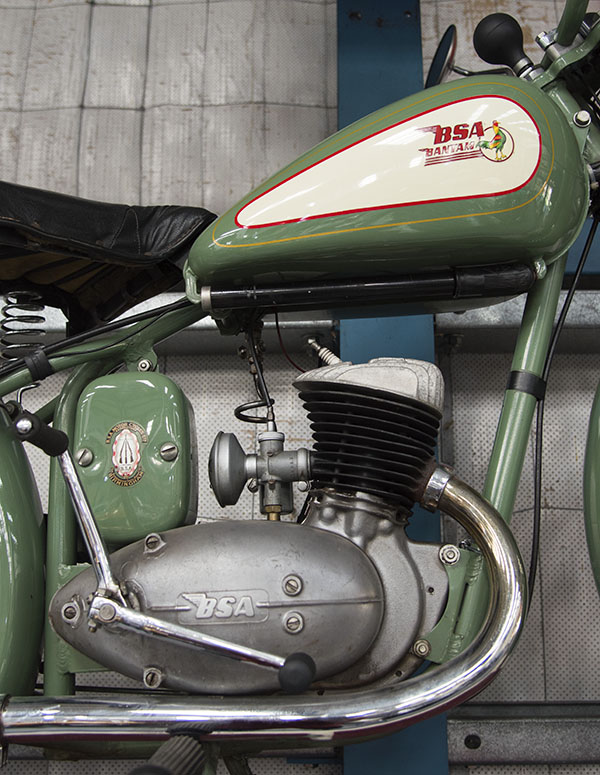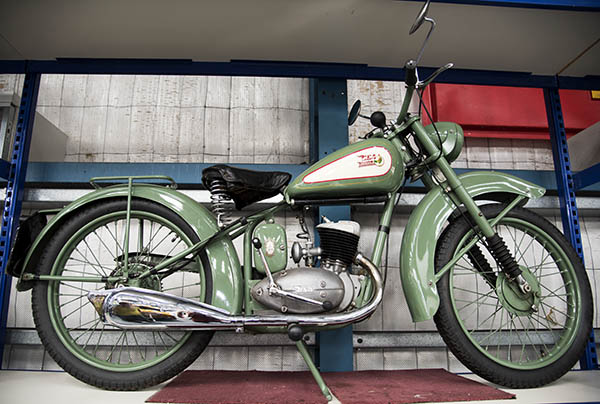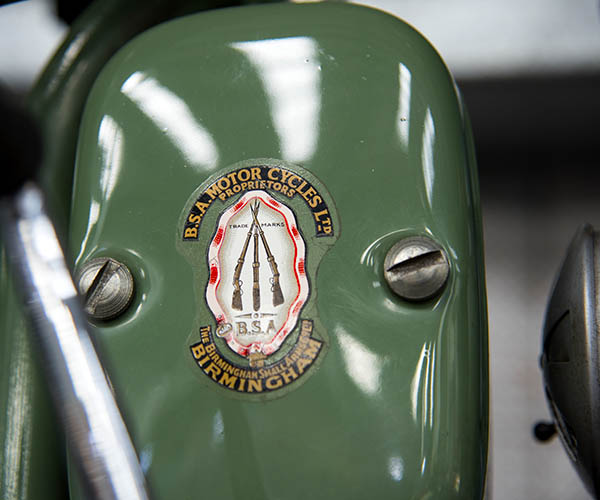I provided just a hint of the Motor Museum of Western Australia’s treasures so far, and a few days ago I started that with this teaser of a Beezer photo…
 The bike you see above is a 1950 125cc two-stroke BSA Bantam, and it’s significant to me because in the late 1960s I actually owned one of those bikes. It was nowhere near as beautiful as the one you see here. My Bantam was painted kind of a rattlecan flat black, it had no muffler, and the lights didn’t work. I bought it for $30 with no title, I rode it in the fields behind our place for a month, and then I sold it for $50 after leaving it on the front lawn for a day with a For Sale sign. Grand times, those were. I didn’t even know the Bantam’s displacement back then, but I knew it was a Bantam, and the thing had a surprising amount of power. I guess that’s what two-strokes do, and it kind of explains good buddy Joe Gresh’s fascination with the oilers. It’s the only ring-a-ding-dinger I ever owned.
The bike you see above is a 1950 125cc two-stroke BSA Bantam, and it’s significant to me because in the late 1960s I actually owned one of those bikes. It was nowhere near as beautiful as the one you see here. My Bantam was painted kind of a rattlecan flat black, it had no muffler, and the lights didn’t work. I bought it for $30 with no title, I rode it in the fields behind our place for a month, and then I sold it for $50 after leaving it on the front lawn for a day with a For Sale sign. Grand times, those were. I didn’t even know the Bantam’s displacement back then, but I knew it was a Bantam, and the thing had a surprising amount of power. I guess that’s what two-strokes do, and it kind of explains good buddy Joe Gresh’s fascination with the oilers. It’s the only ring-a-ding-dinger I ever owned.
The Bantam at the Motor Museum of Western Australia is just flat stunning. I had no idea they came in living color, and I sure like the colors on this one.

Check out the decal on the case behind the engine. I’m guessing it held tools or maybe electrical connections (one of the early Bantam models actually had a battery, but it was located in the headlight).

Everything was mechanical and simple back then. Take a look, for example, at the front brake and its adjustment mechanism. Simple. Cool. You could actually work on a motorcycle without an iPhone or a computer. Better times, I think.
 Some of the old British motorcycles of the 1940s, 1950s, and even into the 1960s had magnificent mufflers. This one stood out.
Some of the old British motorcycles of the 1940s, 1950s, and even into the 1960s had magnificent mufflers. This one stood out.

In researching the Bantam, I found a few facts I did not previously know. For starters, the design was based on a German DKW, and it came to England, Russia, and the US (yep, Harley had a variant) as war reparations at the end of World War II. Incredibly, the British redesigned the engine as a mirror image of the German original to put the shifter on the right side (or, as they might say, the “correct” side). They did a few other things, too, such as converting everything to English units (from metric) and incorporating English electrics (think Lucas, the Prince of Darkness). The 1950 Bantam only had a three-speed gearbox, but it would hit 50 mph. Interesting stuff.
So there you have it. Classic bikes galore. And there’s more. Stay tuned to the ExNotes blog, as we have a few more photos from the Motor Museum of Western Australia to share with you. There’s good stuff coming and you’ll see it right here.
More Dream Bikes? You bet! Just click here!

Hi,i do not mean to be picky,but on a rigid bantam the exhaust pipe should be below the foot peg.
The pipe has a different bend.
i only point this out in the interest of originality.
cheers Dave J.
Yeah – if you look at a DKW you see where the classic “Sporster ” tank came from.